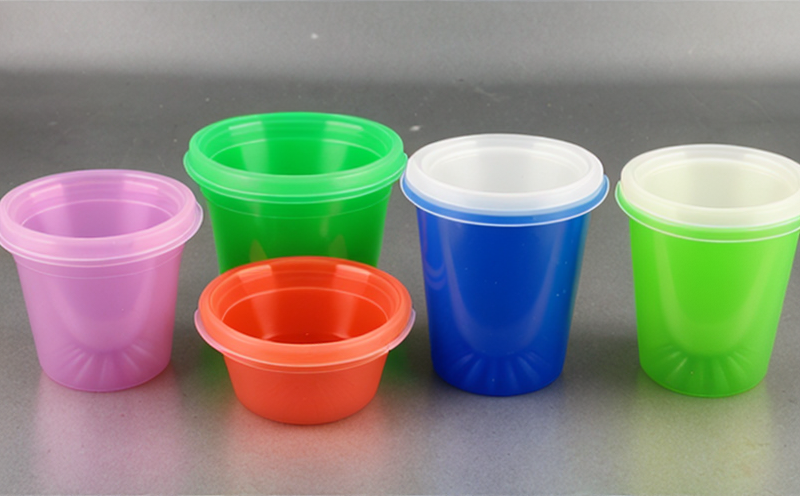EN 14338 Heavy Metal Content Testing of Disposable Plastic Products
In response to growing concerns over environmental sustainability and public health, the European standard EN 14338 provides a framework for ensuring that disposable plastic products do not contain excessive levels of harmful heavy metals. This standard is crucial for manufacturers looking to comply with regulations in the EU and beyond.
The primary focus of this testing is on detecting potential risks associated with heavy metal contamination, particularly those elements known to be toxic at low concentrations. These include lead (Pb), cadmium (Cd), mercury (Hg), chromium (Cr), and other metals that can leach into the environment or come into contact with consumers through use.
The testing procedure outlined in EN 14338 involves several key steps. Specimens are first prepared by cutting them into appropriate sizes and shapes suitable for analysis. Following this, they undergo rigorous extraction processes designed to release any heavy metals present within the plastic matrix. Once extracted, these metals are then analyzed using advanced spectroscopic techniques such as Inductively Coupled Plasma Optical Emission Spectroscopy (ICP-OES) or Atomic Absorption Spectrometry (AAS), both of which offer high precision and accuracy.
The results from this testing process provide critical data on the concentration levels of various heavy metals in disposable plastic products. Compliance with EN 14338 ensures that these concentrations fall within safe thresholds set forth by relevant international standards, including those specified in ISO or ASTM guidelines. This is particularly important for manufacturers aiming to avoid negative impacts on human health and the environment.
By adhering to this testing protocol, companies can demonstrate their commitment to producing environmentally friendly products while also protecting consumer safety. The benefits of meeting these requirements extend far beyond mere compliance; they contribute positively towards building brand reputation and fostering trust among customers.
To better understand how EN 14338 applies specifically within the realm of disposable plastics, it is helpful to consider some real-world examples. For instance, in medical disposables like syringes or intravenous lines, even trace amounts of certain heavy metals could pose significant risks if they migrate into bodily fluids during use. Similarly, food packaging materials must be free from contaminants that might leach into the contents being contained.
It is worth noting that while EN 14338 primarily targets single-use plastics, its principles can also apply to other types of plastic products where heavy metal contamination may present a concern. The overarching goal remains consistent across all applications: ensuring that materials used in disposable items do not contribute unnecessarily to environmental pollution or pose risks to human health.
In summary, EN 14338 Heavy Metal Content Testing plays an essential role in maintaining high standards of product safety and environmental responsibility within the polymer & plastics industry. By conducting thorough analyses according to this standard, businesses not only meet regulatory requirements but also enhance their reputation through proactive measures aimed at safeguarding both people and planet.
Note: For more detailed information on specimen preparation procedures, instrumental methods used in analysis, and interpretation of results, please refer to the official EN 14338 document.
Scope and Methodology
The scope of testing under EN 14338 is broad, encompassing a variety of disposable plastic products that come into contact with food, beverages, or medical applications. The standard aims to ensure these items are free from excessive levels of harmful heavy metals which could potentially migrate onto the product surface during manufacturing processes.
Once samples have been collected, they undergo thorough preparation steps tailored specifically for EN 14338. This includes careful washing procedures to remove any external contaminants before further processing. The subsequent extraction phase utilizes solvents capable of dissolving heavy metal compounds without causing degradation of the plastic matrix itself.
The extracted solutions are then analyzed using sophisticated analytical instruments such as ICP-OES or AAS spectrometers. These devices measure the concentration levels of different heavy metals in parts per million (ppm) or micrograms per gram (µg/g). The results obtained serve as definitive evidence regarding compliance with specified limits outlined in EN 14338.
It is important to note that while the standard focuses on five primary heavy metals—lead, cadmium, mercury, chromium, and other specified elements—the testing protocol can be adapted for additional metals if necessary. This flexibility allows laboratories like Eurolab to cater to specific client needs or emerging regulatory requirements.
- International Acceptance: The findings from EN 14338 heavy metal content tests are widely recognized across Europe and increasingly accepted globally due to its alignment with broader environmental sustainability initiatives. Many countries now reference this standard when formulating their own national regulations.
- Regulatory Compliance: Adhering to EN 14338 ensures that disposable plastic products meet stringent international standards, thereby facilitating smoother market entry into EU member states and other regions where similar requirements apply.
The methodology employed in EN 14338 testing guarantees accurate results through standardized procedures. By following these guidelines meticulously, laboratories can produce reliable data that holds up to scrutiny by regulatory bodies worldwide.
Eurolab Advantages
Expertise and Experience: Eurolab boasts a team of highly qualified professionals who possess deep knowledge in polymer & plastics testing, including specialized training on EN 14338. Our staff stay updated with the latest advancements in analytical techniques to ensure our tests remain state-of-the-art.
Accurate and Reliable Results: Using cutting-edge equipment such as ICP-OES spectrometers and AAS instruments, Eurolab delivers precise measurements of heavy metal concentrations down to parts per million (ppm) sensitivity. Our laboratories are certified ISO/IEC 17025:2017 compliant, guaranteeing that every test meets international quality standards.
Comprehensive Reporting: Beyond just providing numerical values, Eurolab offers detailed reports explaining the testing procedures followed and any deviations from expected outcomes. These insights help clients interpret results more effectively and make informed decisions based on our findings.
Customer-Centric Approach: We understand that each client has unique requirements when it comes to testing disposable plastics for heavy metals. That's why Eurolab works closely with customers throughout the entire process—from sample submission to final report delivery—to ensure satisfaction and alignment with business goals.





